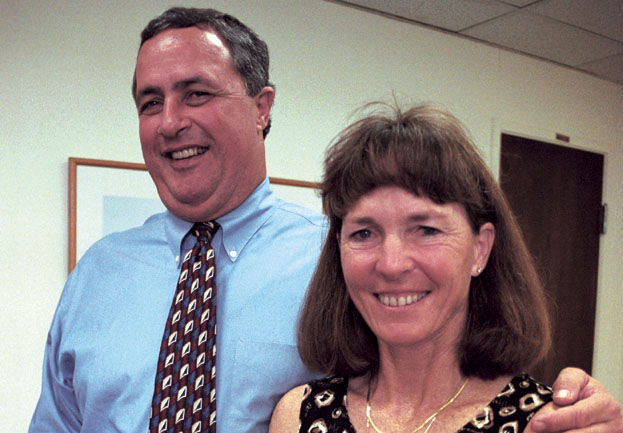
28 years later, letter is finally given
For more pictures, click here.
After 28 years of waiting, former SMU tennis player Maggie Riley-Hagan finally receieved her M, only to have it confiscated by her mother. As her mom held the letter to her heart, next to the pendant M she received in 1939 for her participation in SMU track and field intramurals, she said, “I don’t want to let it go.”
When Riley-Hagan originally asked for her letter in 1974, she was told by an athletic department official, “we don’t do that for girls”.
“It was disappointing,” said Riley-Hagan, because her father and brother lettered at SMU.
Two years before Riley-Hagan graduated, Title IX had been implemented by the department of education, paving the way for women’s participation in college athletics nationwide. Though Title IX was designed to level the collegiate playing field, several women were still snubbed by the universities they represented.
Universities have the choice to comply with one of three Title IX options, including participation opportunities for men and women that are “substantially proportionate” to their perspective undergraduate enrollments, showing continuous growth in women’s collegiate sports at the same institution or to effectively accommodate the interests of the minority gender. Women at SMU make up approximately 54.9 percent of the undergraduate population, but comprise only 43.5 percent of athletic participation, which is 11.4 percent below average.
Women’s sports did not begin until 1969 when Barbara Camp, then a physical education instructor at SMU decided to start a women’s tennis team. She held formal tryout and picked a small squad of women.
The university only chipped in $50 for practice balls, however the team would use their own personal funds to pay for extra expenses such as, tournament entry fees, gasoline and motel bills, said Camp, now the senior women’s administrator for athletics at Auburn University.
The men’s team practiced on “nice courts” while the women’s tennis team were allowed to play on sub-par practice facilities only to “stop during practices because of softballs flying over head from the intramural field next door,” Riley-Hagan said.
As title IX matured, SMU’s ability to provide for women’s sports increased.
“By our senior year, we were able to go to more tournaments,” Riley-Hagan said. While conditions were not acceptable to today’s standards “the university provided us with the opportunity to play.”
Progress didn’t come without its hurdles, particularly on the men’s side. The baseball team was cut in 1980 to both comply with Title IX and ease budget constraints. The men’s golf program was dropped in 1981 and then reinstated three years later because of contributions from the Friends of SMU Golf.
SMU added women’s volleyball and rowing in the late 1990s, will hire an equestrian coach this fall and form a team the following year in Las Colinas. In order to gain proportionality, the university is “strongly looking at adding either women’s lacrosse, softball or field hockey,” said Jim Copeland, director of athletics.
Riley-Hagan is glad she pursued her letter after all these years.
“My daughter is an athlete,” Riley-Hagan said, “and she kept saying I should really go about getting my letter, and when we went on line and looked up about the Letterman’s Association, she said why don’t you write your letter now?”
The fact that her own daughter did not realize the conditions back then gave her a reason to write.
“My daughter almost thought I was joking,” Riley-Hagan said. “I don’t think she believed what it was like back then. I think that was a motivation for me to write my letter.”
Another reason she finally requested her letter was that she had receieved invitations to join the Letterman’s Association, even though she had never formally received the letter necessary for club membership.
Riley-Hagan sent her letter to Jim Copeland and he contacted her.
“After I got the letter, I picked up (the phone) and called her and talked to her. I realized she was sincere about what she was saying and that she had lettered and gotten to that point in her life that she’d like to get those letters that were important to her,” Copeland said. “I told her we don’t have the type of award that they were given back then but we’d be happy to give her the type of letters and awards that athletes were given now.” This type of recognition is very rare after the fact, “I’ve never heard of this being done.”
Riley-Hagan flew from California on June 28 to meet with Copeland, family and friends.
“I feel it’s meaningful to be recognized, I was just hoping to get the letter and I got the watch, and the ring. It was worth the wait. I got some wonderful souveniers.”
The number of women deprived of their letters for four years of athletic participation is not known. But if the athletic department is contacted, many other women can follow Maggie Riley-Haggan’s lead and get their long overdue letters.








